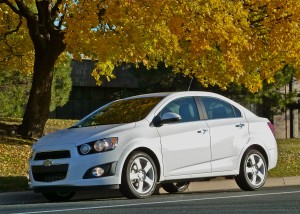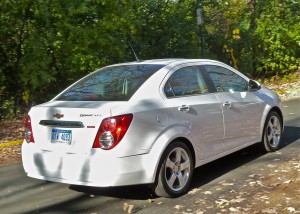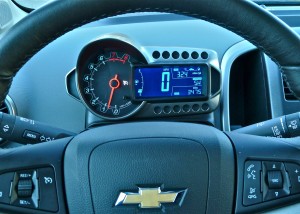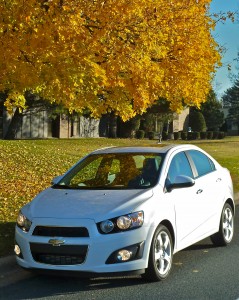Chevy hopes for ‘super’ from 2012 Sonic
By John Gilbert
The 2012 Chevrolet Sonic was introduced just in time for the SEMA electronics extravaganza in early November, 2011, in Las Vegas, which barely gave  Chevrolet time to come out with a specialty model called the “Sonic Boom†for the SEMA show. We can only imagine how long it will take until Chevy PR wizards come up with a “Super Sonic.â€
The normal, garden-variety Sonic is stuck with designations such as LS, LT, and LTZ, but it is intriguing, with sporty looks in either hatchback or sedan designs, and it is sprightly, bordering on sporty, in its performance — at least with the turbocharged choice of engines. It’s important to appreciate the basic Sonic, on its own, of course, and living for a week with the high-end LTZ version, with its turbocharged engine and 6-speed manual transmission, is a good way to study the car.
The Sonic is of vital importance to Chevrolet as it leads General Motors back from the shadows of bankruptcy, and it jumps into the highly competitive subcompact segment, where a herd of vehicles — from the Ford Fiesta to the Honda Fit, Nissan Versa, Mazda2, Toyota Yaris, a couple of Scion models, and the pair of Korean trend-setters , the Hyundai Accent and Kia Rio.
That’s an imposing group to try to invade, with all or most of them offering the latest technology, good performance, high gas mileage, and low basic price. And nobody has heard any of those manufacturers say anything other than that their cars offer the interior amenities of a much more expensive car, because the buyers stampeding to the subcompact segment don’t want a stripped-down econobox any more; they want a small, economical car with a lot of creature features.
Korea is one of the key players in the subcompact surge, because it has made enormous strides in the last decade, but the Hyundai-Kia partnership really caught fire in just the last couple of years. There used to be a half-dozen Korean car companies 20 years ago, in the youthful days of that country’s brief auto history, but one by one they fell by the economic wayside, while Hyundai flourished. Daewoo was among the casualties, and Kia was headed that direction, but as Hyundai took over Kia, General Motors bought out Daewoo, so both remained viable. The new, slick-designed Kia models get to share the high-tech Hyundai drivetrains. And if you bought a Chevrolet Aveo in the last couple of years, you were buying the latest installment of a Daewoo.
The Sonic, then, is the new-for-2012 descendent of the Aveo, but it is much more than that. A Chevrolet official told me that the some of the engineering ideas came from Europe (think Opel), and some of the design came from Asia, while the car itself is assembled in the U.S., at the Lake Orion, Michigan, assembly plant. Its sticker says that U.S./Canadian parts make up 47 percent of Sonic’s content, while Korea offers 20 percent as the major source of foreign parts. Makes you wonder about the remaining 33 percent, but it obviously comes from Europe, or possibly from biodegradable Aveos. At any rate, Chevrolet is justified in calling it a “global†car.
The basic cheapness and uncoordinated feel that plagued the Aveo is nowhere evident in the Sonic. Chevrolet PR claims that it is the only subcompact made in America, which is impressive, even if it sounds odd coming a couple paragraphs after the boasts of it being such a global car. It will be sold all around the world, and its transmission is built in Austria, but it’s good to see GM choosing a U.S. plant as its base.
The engines are built in the U.S., and the Sonic gets its push from the same engines that power the Cruze, Chevy’s highly successful car one step larger, in the compact class. The Cruze is selling very well, even if almost one-third of them are being sold to fleets, and its power is best described as adequate with the 1.8-liter 4-cylinder, or the smaller but turbocharged 1.4-liter 4. The 1.4, without the turbo, is the gas engine used in the plug-in electric Volt, as well.
In the smaller and lighter (2,721 pounds for the sedan, 2,684 for the 5-door hatchback) Sonic, the 1.8 ranges on the high side of displacement, and puts out 138 horsepower and 125 foot-pounds of torque. The smaller 1.4, with its fuel-air mix thrust into it by turbocharging, delivers 138 horsepower and 148 foot-pounds of torque. If it seems odd to offer two engines with identical horsepower, it won’t seem so odd after you drive them both.
The 1.8 has either a 5-speed manual or a 6-speed automatic, and has EPA fuel estimates of 35 miles per gallon highway, with the stick getting a 26-25 edge in city driving. The turbo 1.4 shows EPA estimates of 40 mpg highway and 29 in city driving, with either its upgraded 6-speed manual or the same 6-speed automatic transmission.
Both cars have have bodies built of 60-percent high-strength steel, which is a breakthrough for Chevrolet, which has watched competitors get lighter and stronger before also switching to higher-grade steel. Both are built on the same 99.4-inch wheelbase, but the sedan’s 173.1-inch overall length is 14 inches longer than the hatchback’s 159 inches. Despite the difference, the hatch has slightly more EPA passenger volume (90.6 to 90.4 cubic feet), and remarkably more cargo volume, with 19 cubic feet behind the seats to the sedan trunk’s 14, and folding down the hatchback’s rear seats increases that to 30.7 cubic feet. Being fairly wide (68.3 inches) and tall (59.7 inches) makes the hatchback feel roomy inside, where attention to detailing features a neat little instrument binnacle that Chevrolet says resembles motorcycle gauges, although most young drivers might think it resembles instrumentati on several video games. It has a large, round tachometer on the left, with a square panel on the right housing a large digital speed readout.
The two-tone plastic on the instruments and center stack is remindful of Honda Civics of recent vintage, and the football-like pebble grain on the rest of the dashboard is a nice touch. So are the two glove compartments, one cut into the dash and the other folding out from below.
The Sonic comes as base LS, middle LT or top LTZ. The test-fleet Sonic was the LTZ with the stick shift. In base form, the LS starts out with 10 airbags, a 4-speaker audio, power door locks with rear child security, remote keyless entry, front disc/rear drum brakes, 15-inch aluminum wheels, and a hill-hold feature, at a prilce of $14,495 for the sedan and $15,395 for the hatchback.
Move up to the LT, at $15,695/$16,495 sedan or hatch, and you upgrade to a 6-speaker premium sound system with CD player, XM satellite radio, and power windows, with power and heated outside mirrors, and either 15 or 16 inch wheels.
The LTZ is $17,295 for the sedan, $17,995 for the 5-door, and adds to the lower model features a connectivity package with a USB port, Bluetooth for some phones and music players, steering wheel remote switches, and heated “leatherette†front seats, plus cruise control, foglights, and 17-inch wheels. Apparently there is no way to upgrade to 4-wheel disc brakes, although the test car added a premium power sunroof for $850, and the 1.4 Turbo engine plus the 6-speed manual as a $700 option. Including destination, that runs the price up to $18,845.
Driving the Sonic, I found, was much more satisfying than driving the Cruze, which I found had an automatic with balky shifting, where even flipping the steering wheel paddles was followed by a 2-second delay before enacting an upshift. The 6-speed manual in the Cruze Turbo had an odd gate that, when you wanted a quick downshift to second going around a corner at 35 mph, would instead send you and the gear lever off too far to the left to engage either second or first, as if you were considering going over to try to find reverse, unadvisable as it may seem at 35 miles per hour.
After driving the Cruze, I didn’t say anything about the stick shifter to my wife, Joan, my trusted alternate test-driver, but she called on her cell phone during a 165-mile freeway jaunt from Duluth to Minneapolis and said she liked the looks, the interior features, and the ergonomics, but she found the seat gave her a bit of a backache, and she added, “What’s with this shifter?†I had to laugh. In summary, Joan said: “I think the Cruze is a great little car, if you didn’t have to sit in it or shift it.â€
One more tidbit about the Cruze is that Motor Trend ranked it sixth among compacts, behind the Hyundai Elantra, Honda Civic, Mazda3, Volkswagen Jetta, and Ford Focus, and declared it “saddled with a thirsty, inept powertrain.â€
The Sonic, pleasantly, gets more out of the same 1.4-liter Turbo, and shifting was a breeze with the 6-speed stick. Not that it was perfect, or even approximating segment-leading status. In city driving, the turbo kick made the Sonic fun, because it comes in with a rush at about 2,000 RPMs, and running up through the gears offers a similar kick at each stop. However, you have to adapt to working the clutch and gas to launch smoothly, because if you give it enough gas to start quickly, the turbo kick will send you zooming away much faster than you anticipate. Not a good thing in congested traffic.
On the other hand, I was surprised considerably on that familiar Duluth-to-Minneapolis stretch of Interstate 35, which has about a half dozen gently rolling hills to interrupt the prairie geography as it nears Lake Superior, that trying to cruise up even the slightest rise in sixth gear saw the revs drop and drop, until close to 1,000 revs, and I actually had to downshift to either fifth or even fourth to avoid bogging down the engine.
The Sonic corners well enough, but the electric power-steering was light and devoid of road feel. That became more of a problem on that freeway trip, either singularly or in concert with other factors. That stretch of freeway has just completed a summer-long lengthy stretch of repaving, the Sonic had Hankook Optimo tires that were not low-profile, on 17-inch wheels, and those ingredients, coupled with the unfeeling steering was not aided by some brisk, 20-mph headwinds. I would estimate that I made approximately a million tiny corrections on that trip, even while focusing completely on the highway ahead with both hands on the wheel. Any checking on the instruments or the satellite radio settings had to be kept to the briefest of glances, or else you might find you’d wandered across the dotted line into the adjacent lane.
Holding steady to 70 with occasional gusts to 75, I attained 36.5 miles per gallon, which dipped only to 32 mpg including a couple days of city driving. That’s very good, except when compared to the Accent or Fiesta, which both delivered over 40 mpg on the same trip. It also tends to make the Sonic’s EPA estimate of 40 mpg seem good only for Chevrolet advertising types.
Overall, however, the good outweighs the nitpicks with the Sonic, which, overall, makes the Sonic a very impressive entry into the subcompact tangle. The upgraded audio system is amazingly good, eliciting high praise from older son Jack, a guitarist and audio fanatic, as well as bringing out subtle undertones and avoiding distortion even at ear-splitting levels. The dashing looks and the interior amenities make the interior a pleasant place to be, and a small tweak to the steering and maybe different tires — or driving on less-windy days — might take care of the freeway wandering. On top of that, Joan had only positives in her evaluation of the Sonic after a lengthy drive, shifting smoothly in congested traffic and finding nothing resembling a pain in the back.
Comments
Tell me what you're thinking...
and oh, if you want a pic to show with your comment, go get a gravatar!






 John Gilbert is a lifetime Minnesotan and career journalist, specializing in cars and sports during and since spending 30 years at the Minneapolis Tribune, now the Star Tribune. More recently, he has continued translating the high-tech world of autos and sharing his passionate insights as a freelance writer/photographer/broadcaster. A member of the prestigious North American Car and Truck of the Year jury since 1993. John can be heard Monday-Friday from 9-11am on 610 KDAL(www.kdal610.com) on the "John Gilbert Show," and writes a column in the Duluth Reader.
John Gilbert is a lifetime Minnesotan and career journalist, specializing in cars and sports during and since spending 30 years at the Minneapolis Tribune, now the Star Tribune. More recently, he has continued translating the high-tech world of autos and sharing his passionate insights as a freelance writer/photographer/broadcaster. A member of the prestigious North American Car and Truck of the Year jury since 1993. John can be heard Monday-Friday from 9-11am on 610 KDAL(www.kdal610.com) on the "John Gilbert Show," and writes a column in the Duluth Reader.